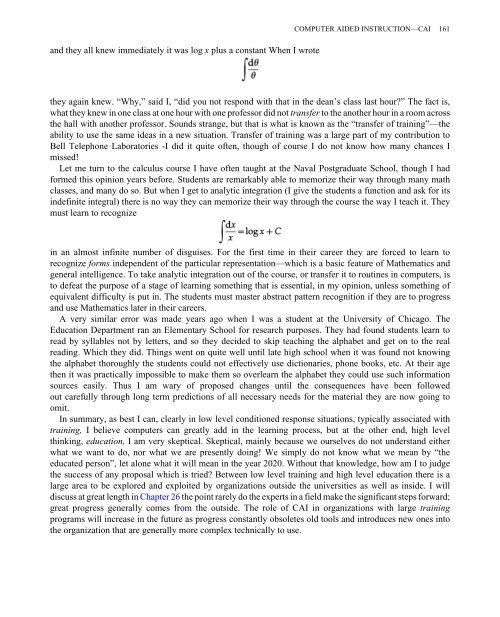hamming
hamming
hamming
Create successful ePaper yourself
Turn your PDF publications into a flip-book with our unique Google optimized e-Paper software.
and they all knew immediately it was log x plus a constant When I wroteCOMPUTER AIDED INSTRUCTION—CAI 161they again knew. “Why,” said I, “did you not respond with that in the dean’s class last hour?” The fact is,what they knew in one class at one hour with one professor did not transfer to the another hour in a room acrossthe hall with another professor. Sounds strange, but that is what is known as the “transfer of training”—theability to use the same ideas in a new situation. Transfer of training was a large part of my contribution toBell Telephone Laboratories -I did it quite often, though of course I do not know how many chances Imissed!Let me turn to the calculus course I have often taught at the Naval Postgraduate School, though I hadformed this opinion years before. Students are remarkably able to memorize their way through many mathclasses, and many do so. But when I get to analytic integration (I give the students a function and ask for itsindefinite integral) there is no way they can memorize their way through the course the way I teach it. Theymust learn to recognizein an almost infinite number of disguises. For the first time in their career they are forced to learn torecognize forms independent of the particular representation—which is a basic feature of Mathematics andgeneral intelligence. To take analytic integration out of the course, or transfer it to routines in computers, isto defeat the purpose of a stage of learning something that is essential, in my opinion, unless something ofequivalent difficulty is put in. The students must master abstract pattern recognition if they are to progressand use Mathematics later in their careers.A very similar error was made years ago when I was a student at the University of Chicago. TheEducation Department ran an Elementary School for research purposes. They had found students learn toread by syllables not by letters, and so they decided to skip teaching the alphabet and get on to the realreading. Which they did. Things went on quite well until late high school when it was found not knowingthe alphabet thoroughly the students could not effectively use dictionaries, phone books, etc. At their agethen it was practically impossible to make them so overlearn the alphabet they could use such informationsources easily. Thus I am wary of proposed changes until the consequences have been followedout carefully through long term predictions of all necessary needs for the material they are now going toomit.In summary, as best I can, clearly in low level conditioned response situations, typically associated withtraining, I believe computers can greatly add in the learning process, but at the other end, high levelthinking, education, I am very skeptical. Skeptical, mainly because we ourselves do not understand eitherwhat we want to do, nor what we are presently doing! We simply do not know what we mean by “theeducated person”, let alone what it will mean in the year 2020. Without that knowledge, how am I to judgethe success of any proposal which is tried? Between low level training and high level education there is alarge area to be explored and exploited by organizations outside the universities as well as inside. I willdiscuss at great length in Chapter 26 the point rarely do the experts in a field make the significant steps forward;great progress generally comes from the outside. The role of CAI in organizations with large trainingprograms will increase in the future as progress constantly obsoletes old tools and introduces new ones intothe organization that are generally more complex technically to use.


